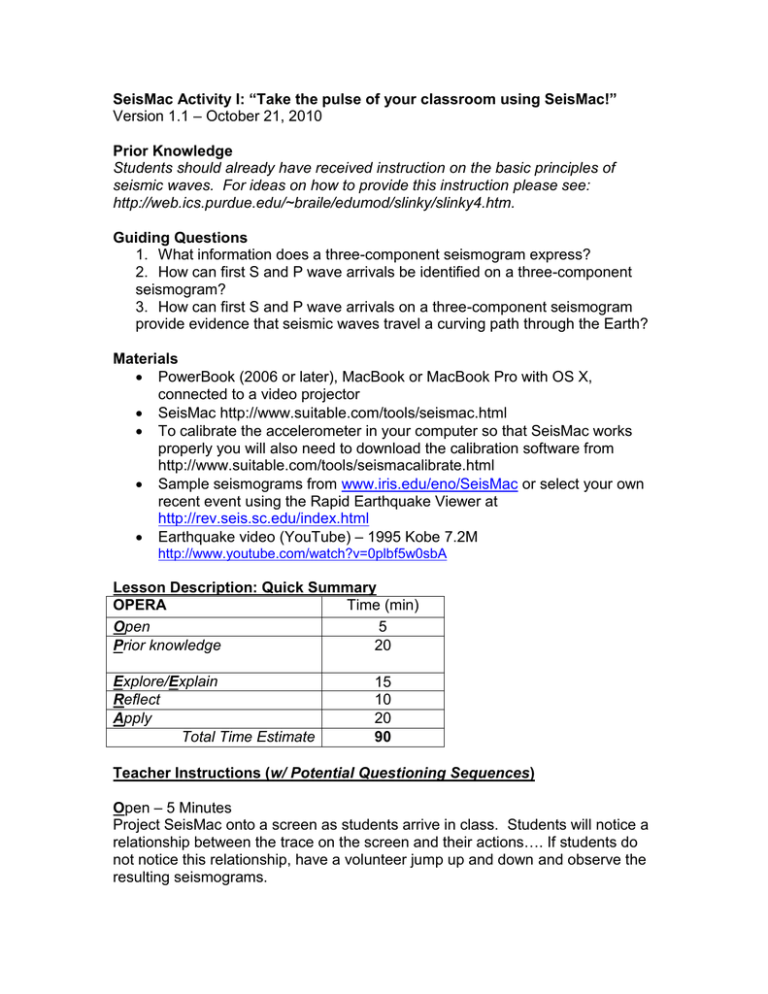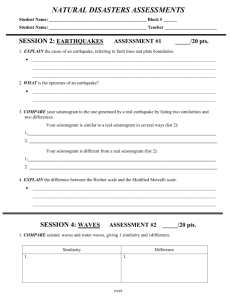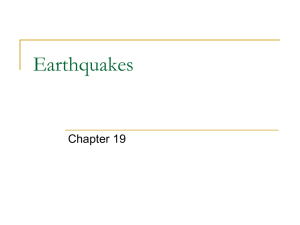Word Version fo Activity
advertisement

SeisMac Activity I: “Take the pulse of your classroom using SeisMac!” Version 1.1 – October 21, 2010 Prior Knowledge Students should already have received instruction on the basic principles of seismic waves. For ideas on how to provide this instruction please see: http://web.ics.purdue.edu/~braile/edumod/slinky/slinky4.htm. Guiding Questions 1. What information does a three-component seismogram express? 2. How can first S and P wave arrivals be identified on a three-component seismogram? 3. How can first S and P wave arrivals on a three-component seismogram provide evidence that seismic waves travel a curving path through the Earth? Materials PowerBook (2006 or later), MacBook or MacBook Pro with OS X, connected to a video projector SeisMac http://www.suitable.com/tools/seismac.html To calibrate the accelerometer in your computer so that SeisMac works properly you will also need to download the calibration software from http://www.suitable.com/tools/seismacalibrate.html Sample seismograms from www.iris.edu/eno/SeisMac or select your own recent event using the Rapid Earthquake Viewer at http://rev.seis.sc.edu/index.html Earthquake video (YouTube) – 1995 Kobe 7.2M http://www.youtube.com/watch?v=0plbf5w0sbA Lesson Description: Quick Summary OPERA Time (min) Open 5 Prior knowledge 20 Explore/Explain Reflect Apply Total Time Estimate 15 10 20 90 Teacher Instructions (w/ Potential Questioning Sequences) Open – 5 Minutes Project SeisMac onto a screen as students arrive in class. Students will notice a relationship between the trace on the screen and their actions…. If students do not notice this relationship, have a volunteer jump up and down and observe the resulting seismograms. Prior Knowledge – 20 Minutes Taxonomy Knowledge Question What kinds of graphs are being shown on the screen? Answer Line graphs Pause the display on SeisMac using the yellow pause/play button. Taxonomy Comprehensio n Comprehensio n Question Can someone help us interpret these graphs? What information is being shown across the bottom? What information is being shown on the vertical axis? Answer The horizontal axis shows the “real time” from your computer’s clock. This is displayed in hours, minutes and seconds. The vertical axis shows the acceleration in units of gravity (g). Activity two focuses on helping students develop an understanding and appreciation of ground acceleration. Based on this graph, what do you Accept all answers but lead think this program is designed to students to realize that the do? What makes you think this? computer and software are recording the motion of the ground in their classroom. Instruct students to create a Circle Map for the term “seismogram” to gain a sense of their prior knowledge of the subject. “Circle Maps are tools used to help define a thing or idea. It is used to brainstorm ideas and for showing prior knowledge about a topic. In the center of the circle, use words, numbers, pictures, or any other sign or symbol to represent the object, person, or idea you are trying to understand or define. In the outside circle, write or draw any information that puts this thing in context.” For more information go to… http://www.mdianeharrison.com/Thinking%20Maps.htm Explore/explain – 15 Minutes Show video clip (YouTube) of the 1995 Kobe earthquake (7.2M) http://www.youtube.com/watch?v=0plbf5w0sbA to help establish relevance. Taxonomy Application Question What do you think the display of Answer Accept all answers but lead Analysis Analysis SeisMac might look like if it had been sitting in that room and running when that earthquake occurred? Why do you think the software shows three graphs to measure the motion of the ground? Propose an experiment that could be conducted to explain the three traces students to understand that the lines would be very squiggly... one might even suggest that they may look like a seismogram! Accept all answers Try student experiments or tilt the laptop gently three different ways First Position (Sitting normally) Taxonomy Analysis Second Position (Stood up on edge) Question What is the relationship between these physical motions and the graph? Third position (Sitting on the screen with the keyboard up. Answer Lead students to realize that motion has three components (X,Y,Z) and that each is represented on a separate trace on the graph. Students might also note that the harder the shaking, the higher and lower the line goes on the graph. Thus there is a correlation to the amount of energy released. Reflect – 10 Minutes Revisit the circle maps students created for the term seismogram. Use a different color (pen, pencil or markers) as students update their maps by adding new information, editing or clarifying existing information, and possibly removing incorrect or irrelevant information. Apply - 20 Minutes Distribute the sample three-component seismogram or one from a recent earthquake of your own choosing from http://rev.seis.sc.edu/index.html Taxonomy Comprehensio n Question How is this graph similar to what we see on the screen? Comprehensio n Review the axis of the seismograms with the students and ask students to pick the P (first signal to arrive) and S (second signal) wave arrivals on the seismogram you distributed. Comprehensio n In which component is most of the energy for the P wave?... for the S wave? Application Why do you think this is the case? Answer Lead students to understand that the seismic data is a threecomponent graph similar to the one produced by SeisMac. Sample Seismogram #1: The P wave. best seen in the vertical component, arrives at ~235 seconds. The S wave, best seen in the North-South (horizontal) component, arrives at ~685 seconds. Most of the energy for the P wave is generally found in the vertical component, while most of the energy for the S wave is generally found in one of the horizontal components. Accept all answers but suggest that students explore this by trying to replicate the seismogram by moving the laptop. Have a volunteer try to replicate the motion shown in this seismogram by shaking the laptop. Replicate the motion of the P arrival first, then the motion for the S arrival, and finally put the two together. Taxonomy Comprehensio n Application Question Can someone summarize how __________ (student’s name) had to move the computer for the P wave?… for the S wave? Answer For the P wave, most of the motion is likely to be seen in one of the horizontal components. For the S wave, the majority of the energy is likely to be seen on the vertical components. Based on what you already know Waves from distant earthquakes follow a curving path through the about particle motion compared Earth. As a result they arrive at to the direction of travel for seismic stations from below. Since seismic waves (e.g. particles the motion of a P wave is in the move parallel to the direction of direction the wave travels, for a wave propagation for P waves), how did the seismic energy arrive wave coming up from below the at the station that recorded this earthquake?” seismograph station, the motion of the ground will be mostly vertical (up and down), with a smaller amount of motion on the horizontal components (North and East). By contrast, since the S wave motion is perpendicular to the direction of wave travel, an S wave coming up under the station will produce larger motion in a horizontal direction which may be some combination of the North and East component directions, and smaller motion on the vertical component. To connect the seismograms students have studied to actual earthquake ground motion, re-show the 1995 Kobe earthquake (7.2M) video clip http://www.youtube.com/watch?v=0plbf5w0sbA and challenge students to identify the arrivals of the different seismic waves in the video. Challenge Answer: At about 1 second into the video clip, you see a man who was laying down suddenly sit up so his head appears in the bottom center of the screen. He was likely to have been awakened by the P wave. At approximately 4 seconds into the clip, the first horizontal motion begins which is likely to be the S wave either combined with or very closely followed by the arrival of the surface waves. Many thanks to Michael Wysession of Washington University at St. Louis, who developed the initial conception of this activity. Sample Three-Component Seismogram – 3/28/05 N. Sumatra M 8.7






